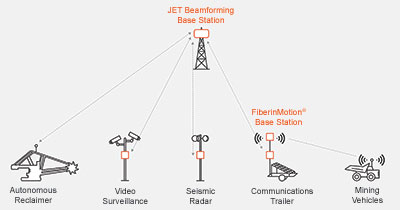

Communication is essential on a mine, whether it is being able to keep in contact with miners underground, or to have a reliable communications network covering the surface area of the mine. In many, if not most instances, mines are inconveniently located to have the communications options city dwellers consider ‘normal’, which means mines need to make a plan for themselves.
Given the large areas mines cover, a wired communication network is not really viable if one wants to cover the whole area of the mine. For the primary working and processing areas it is potentially viable to lay cables, but is it the best decision for all sorts of communications, from voice to data – which could include surveillance video streams?
Wireless solutions make more sense if a mine, or any environment with large open areas, wants a reliable communications platform. Using 3G or 4G technology is probably the best and easiest solution given its broad rollout in South Africa, but these solutions do not always offer a reliable and predictable service. Moreover, if your service provider has a problem, so do you, notes Ryan Dunford, Radwin product manager at MiRO Distribution.

Dunford says a private wireless network from Radwin (although there are many providers out there), uses the unlicensed 5 GHz spectrum and is suitable for creating a strong network backbone that can reliably and securely handle all forms of data. For example, the company’s beamforming technology (officially called the JET Smart Beamforming Point-to-MultiPoint technology) ensures that multiple streams of bidirectional data can be handled without interference.
This technology can support bandwidths of up to 1,5 Gbps per sector or 6 Gbps per cell, meaning it can handle almost anything thrown at it, including perimeter surveillance solutions (for example). Users also receive a standard service-level agreement (SLA) which makes it easier to plan the network, knowing what it can deliver in advance.
For outlying areas, or when specific areas need more bandwidth (such as watching illegal miners invading a new area), Dunford says Radwin’s FiberinMotion offers a mobile extension to the set wireless network. These mobile base stations can monitor extended areas not covered by the primary base station and can even be driven via solar power while out in the field. FiberinMotion supports up to 750 Mbps and can provide coverage of up to 5 km.
Dunford adds that Radwin’s equipment for mines sports an IP67 rating, making it durable in tough outdoor conditions. There are also, naturally, various products that can be selected to meet specific communications needs.
As noted above, Dunford says there are various products that can be used to create communications networks. The key is to understand what each customer’s requirements are and to plan efficiently to meet those needs. He adds that MiRO is geared to offer this type of support and more for projects that will make use of wireless networks, ensuring the solution delivers as required.
| Tel: | +27 12 657 0960 |
| Email: | [email protected] |
| www: | www.miro.co.za |
| Articles: | More information and articles about MiRO |

© Technews Publishing (Pty) Ltd. | All Rights Reserved.